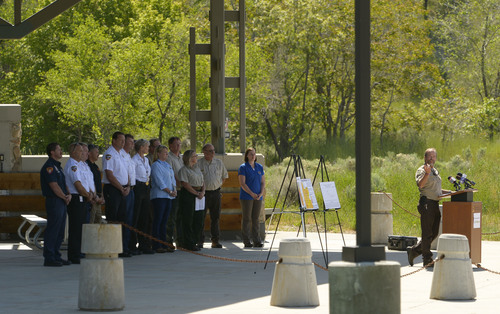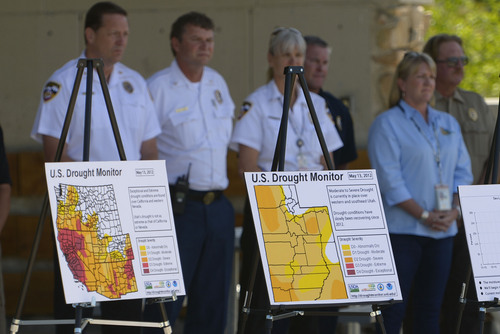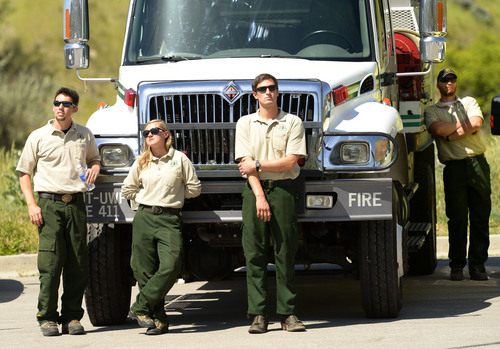This is an archived article that was published on sltrib.com in 2014, and information in the article may be outdated. It is provided only for personal research purposes and may not be reprinted.
As wildfire crews battle smoke and flames this summer, they have a recent reminder of what mistakes on the ground and back at headquarters can cost.
The Yarnell Hill fire, which took the lives of 19 firefighters last year in Arizona, has Utah's fire defenders talking about they can learn from the tragedy.
The need for clear communication and always putting people before property were topics during the lead-up this summer's wildfire season, which officially started June 1. Officials also emphasized the danger of falling into complacency.
"[Yarnell Hill is] definitely in the front of our minds," said Jessica Osborne, a six-year firefighter with the U.S. Forest Service.
On June 30, 2013, the Granite Mountain Hotshots were trapped as a fierce thunderstorm changed the direction of the flames they were battling near the small community of Yarnell, Ariz.
A commission that oversees workplace safety blamed state fire officials for knowingly putting protection of property ahead of safety and said the crew should have been pulled out earlier.
Marshall Krotenberg, the safety agency's lead investigator, told commissioners that senior fire managers had already determined that the town was indefensible, and that fire managers should have removed firefighters an hour before the thunderstorm arrived. Everyone knew the storm was anticipated, but "there was no plan to move people out of the way," he said.
The commission's chairman, David Parker, said he believed the fire management team on site did everything in its power to defend the community and provide for the safety of people. "It's not the intention of the people that (is) in question, it's that employees remained exposed after they no longer should be exposed," Parker said.
The commission's findings reverberated throughout the wildfire community, on a nationwide scale. Cheryl Probert, a deputy forest supervisor, mentioned at a press event last month that tragedies like Yarnell Hill serve as a reminder that keeping people safe sometimes means letting property burn.
A new batch of firefighters will soon wrap up their training, and the U.S. Forest Service in Utah has been drilling into them that their lives and the safety of the people around them is not worth a building.
The Forest Service has been hitting that same message hard at every pre-season meeting with fire officials around the state.
"[With tragedy like Yarnell] does come that focus, and we are hypersensitive to that," said Loyal Clark, a Forest Service spokeswoman.
During a week-long training session last month, one of the Yarnell Hill investigators shared the probe's findings with Utah officials and what they can take away from that.
Not falling into complacency was one lesson, said Jason Curry, spokesman for the Utah Division of Forestry, Fire and State Lands.
The 19 Hotshots were trained, experienced professionals, but even they got into trouble. Not that the Hotshots became complacent, Curry added, but their deaths underscore that no one is immune to danger.
Mike Stoutsenberger, a Forest Service firefighter, echoed that lesson at last month's press event. Standing by his fire truck, Stoutsenberger explained how they understand that risk is part of the job, but it's important that they not to lose focus on their safety — even though it gets easier to lose that focus toward the end of the season as fire after fire wears them down.
Another takeaway was clear communication, as well as the importance of making clear decisions and having a solid plan in any case, Curry said.
"These are not new things, but they are things to re-emphasize," he said.
Also in the wake of Yarnell Hill, the National Association of State Foresters asked the National Wildfire Coordinating Group to review what technology is available to track resources in real-time, analyze the "human factors" in fire fighting, and how they use air suppression, according to a BLM report.
The BLM also bumped up their periodic review of their fire shelters to this year instead of 2015. The shelters — fire-resistant bags that firefighters can fall on the ground and throw on — can provide last-ditch protection for firefighters who can no longer outrun an inferno. The review considers new materials with which to make the shelters, as well as the current shelters' weight and performance, among other factors.
All of those reviews are still ongoing, as far as Curry knows, and he is anxiously awaiting the results.
"Whenever we have a tragedy within the wild land fire arena, we definitely reflect every year on those sorts of accidents and try to analyze what went wrong and/or how we can make sure this doesn't happen again," said Heather O'Hanlon, spokeswoman for the Utah BLM.
Amid all of the lessons that firefighters can takeaway, there has been a push for residents to meet them halfway, such as by clearing vegetation around their homes to create what's called defensible space.
"What we've talked about in the firefighter community as a whole, we're kind of disappointed with homeowners in that urban interface," said Jason Kirks, a BLM fire management specialist in the Moab office. "In the wake of all the tragedy, and all the homes that have burned down, and people are [still] not fixing up their property. We're very disappointed that people are not doing what they need to do."
The Rockport 5 Fire tore through Summit County last August and destroyed eight homes. But resident Pat Pike's was spared, the flames ending right at his driveway — apparently thanks to the time he spent removing brush from his property, long before the fire started.
Kirks hope others will learn from that.
"You'll see that over and over again," Kirks said. "A large destructive fire, one or two homes survive, a lot of times the homeowner did something to [make their home safer beforehand]."
Clark pointed homeowners to UtahFireInfo.gov, where they can learn how to preemptively protect their homes.
Experts forecast that this wildfire season will be a "normal" one, with an expected El Nino keeping temperatures down and humidity up. But Curry pointed out that tragedy strikes in the average years, too.
As O'Hanlon said, "Sometimes Mother Nature just gets the better of you."
— The Associated Press contributed to this story.
Twitter: @mikeypanda







